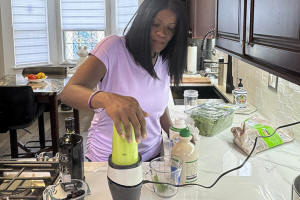To stay sharper while aging, get active, challenge your brain, and eat
healthy
[July 29, 2025]
By LAURAN NEERGAARD
WASHINGTON (AP) — It’s official: Older Americans worried about cognitive
decline can stay sharper for longer by exercising both their bodies and
their brains and eating healthier.
That’s according to initial results released Monday from a rigorous U.S.
study of lifestyle changes in seniors at risk of developing dementia.
People following a combination of healthier habits slowed typical
age-related cognitive decline — achieving scores on brain tests as if
they were a year or two younger, researchers reported in JAMA and at the
Alzheimer’s Association International Conference.
It’s not too late to get started -- study participants were in their 60s
and 70s -- and it doesn’t require becoming a pickleball champ or
swearing off ice cream.
“It was the first time I felt like I was doing something proactive to
protect my brain,” said Phyllis Jones, 66, of Aurora, Illinois, who
joined the study after caring for her mother with dementia and
struggling with her own health problems.
It’s too soon to know if stalling age-related decline also could reduce
the risk of later Alzheimer’s or other forms of dementia. But Jones and
other study participants underwent brain scans and blood tests that
researchers now are analyzing for clues – such as whether people also
saw a reduction in Alzheimer’s-related protein buildup.
“We’re all on a cognitive aging clock and anything we can do to slow
that clock down, to me, that is a significant benefit,” said Laura Baker
of Wake Forest University School of Medicine, who led the study.

What’s good for the heart is good for the brain
Doctors have long encouraged physical activity and a healthy diet for
brain fitness. Those steps fight high blood pressure and cholesterol,
heart disease and diabetes, factors that increase the risk of dementia.
But until now the strongest evidence that specific lifestyle changes
later in life could improve how people perform on brain tests came from
a study in Finland.
Would it work for a more sedentary and culturally diverse U.S.
population? With funding from the Alzheimer’s Association and the
National Institute on Aging, Baker’s team tested the strategy for two
years in 2,100 adults ages 60 to 79.
Here's what study participants had to do
Half of participants were randomly assigned to group classes for
exercise and dietary changes plus brain-challenging homework – with peer
support and coaches tracking their progress.
They did a half-hour of moderately intense exercise four times a week --
plus twice a week, they added 10 to 15 minutes of stretching and 15 to
20 minutes of resistance training.
They followed the “MIND diet” that stresses lots of leafy greens and
berries plus whole grains, poultry and fish. Nothing is banned but it
urges limiting red meat, fried or “fast food” and sweets, and
substituting olive oil for butter and margarine.

[to top of second column]
|

In this photo provided by Phyllis Jones, she prepares a smoothie
with spinach, frozen blueberries, almond milk with pumpkin spice and
date sugar at home in Aurora, Ill., on Friday, July 25, 2025.
(Courtesy Phyllis Jones via AP)

They also had to meet someone or try something new weekly and do brain
“exercises” using an online program called Brain HQ.
Other study participants, the control group, received brain-healthy
advice and minimal coaching — they chose what steps to follow.
Both improved but the groups fared significantly better.
Combining social engagement with exercise and dietary steps may be key,
said Jessica Langbaum of the Banner Alzheimer’s Institute, who wasn’t
involved with the study.
“Americans want to have that one easy thing – ‘If I just eat my
blueberries,’” Langbaum said. “There is no one magic bullet. It is a
whole lifestyle.”
How to exercise your body and mind on your own
Moderately intense physical activity means raising your heart rate and
panting a bit yet still able to talk, said Wake Forest’s Baker. Pick
something safe for your physical capability and start slowly, just 10
minutes at a time until you can handle more, she cautioned.
Make it something you enjoy so you stick with it.
Likewise there are many options for brain exercise, Baker said –
puzzles, joining a book club, learning an instrument or a new language.
Jones, a software engineer-turned-tester, learned she loves
blueberry-spinach smoothies. Her favorite exercise uses an at-home
virtual reality program that lets her work up a sweat while appearing to
be in another country and communicating with other online users.
One challenge: How to keep up the good work
Researchers will track study participants’ health for four more years
and the Alzheimer’s Association is preparing to translate the findings
into local community programs.

Will people with stick with their new habits?
Jones lost 30 pounds, saw her heart health improve and feels sharper
especially when multitasking. But she hadn't realized her diet slipped
when study coaching ended until a checkup spotted rising blood sugar.
Now she and an 81-year-old friend from the study are helping keep each
other on track.
The lifestyle change “did not just affect me physically, it also
affected me mentally and emotionally. It brought me to a much better
place,” Jones said.
All contents © copyright 2025 Associated Press. All rights reserved |